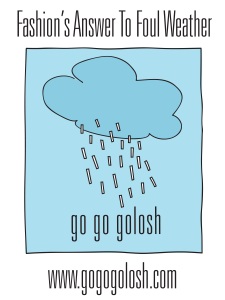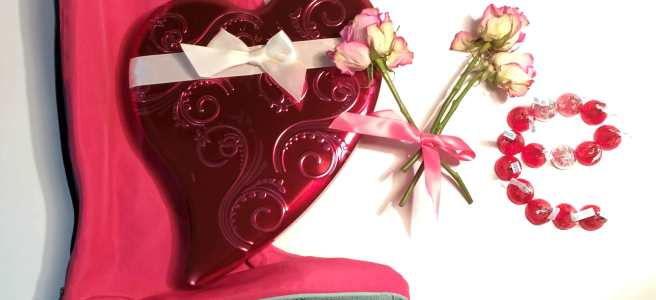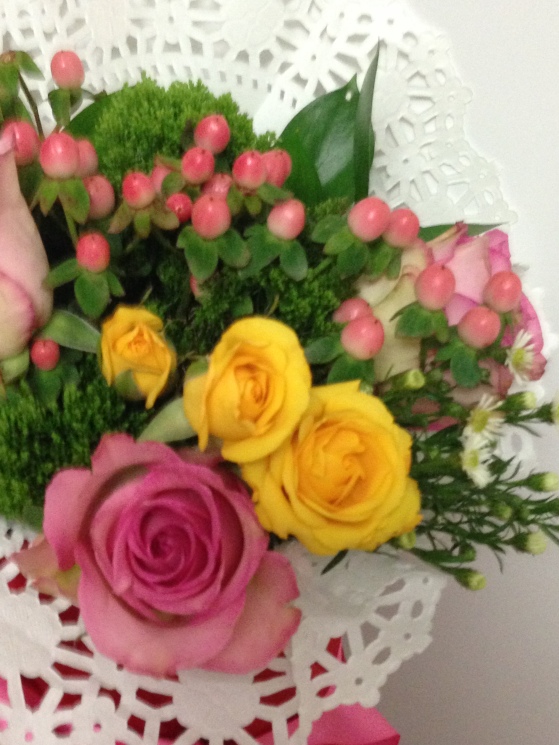“I am my hair.” I couldn’t agree more with this Lady Gaga lyric. Personally, my hair is my number one priority. The problem is that my hair has a personality of its own. No matter what I want it to do, it doesn’t do I want it to. If I want to curl my hair, it curls too much. If I want to wear it flat, it decides to be puff up. I’ve been at war with my hair for as long as I can remember.
This post has been in the works for a long time; there is just too much information to share, so we will have a Hair “series.” How much information could there possibly be on hair care you may ask? Surprisingly, a lot. In this series, I will be focusing on natural care vs commercial care. When I say natural care, I mean that I will share wonderful ways to keep your hair healthy with things you can find in your kitchen, garden or any grocery store. Commercial care refers to branded products, like Pantene, Serum, etc. This series of posts will cover the basics and first steps to obtaining healthier hair, naturally.
THE BASICS
There are several things we need to know about dealing with our hair to proceed. Porosity, type, dryness, water hardness, and what type of weather will be affecting it.
Porosity. Knowing your hair porosity is key to determining what ingredients work best for your mane. Lack of moisture causes frizz, dry and dull hair. It’s the outer layer of your hair, the hair cuticle that determines its ability to absorb and hold moisture. Not your hair texture. There are two ways of knowing your hair porosity.
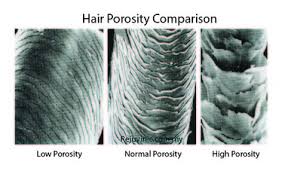
One way is to get a clear glass of water and drop a strand of hair in the cup. You don’t have to pull a hair out of your head. A strand from one of your brushes will work. If the hair sinks right away you have high (raised) porosity, if it takes a long time its low (compact) porosity. Normal porosity is somewhere in the middle.
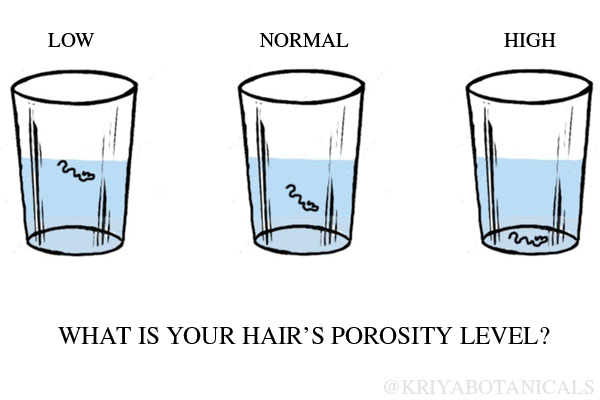
Carefully section off a very small group of strands of your hair. Next, take the group of strands between two fingers and begin to slide your fingers up toward the roots.The more ruffles your hair makes, the more porous your hair is. Low porosity hair will allow your fingers to slide up easily without out ruffling. High porosity hair will feel rough and ruffle all the way up.
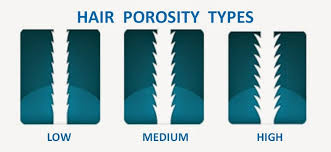
Water hardness The simple definition of water hardness is the amount of dissolved calcium and magnesium in the water.
Hard water is high in dissolved minerals, both calcium and magnesium.
Soft water has fewer minerals. The mineral content comes from the type of rocks the water has been filtered through underground. It has nothing to do with water quality.
To find out what type of water you have, you can ask your water company, many have it on their websites. A different way is to take a jar or glass and half fill it with water and leave it for a few days. If there’s a white ring on the glass then the water is hard.
Once you have all the questions answered you can start understanding what your hair needs and how to care for it properly.
Simple things to change from your routine that can and will improve your hair healths:
*Switch your pillowcase to a Satin/Silk pillowcase. Why? This will control the frizz caused by moving around, rubbing your head on the pillowcase while you sleep. I took it a step further and bought some silk and made a head wrap that I wear every night, and every morning I wake up with really shiny hair.
*Protect your hair from sun, wind and humidity. If the sun is shining bright like a diamond or if it’s windy outside wear a hat or scarf. Make sure to cover your hair. Too much flowing around in the wind can tangle your hair and the excess sun is as damaging for your hair as it is on your skin.
*Avoid heat. Your hair can withstand a temperature of 450F before burning or becoming damaged. Simply using heat does not automatically mean that your hair is or will become damaged. In most cases, healthy hair will only experience heat damage with excessive use of heat or using heat appliances at temperatures of 450F or more. When your hair is damaged by heat, it’s permanently damaged.
*Avoid hot water. Warm water is ok. Test the water on the back of your hand, if it burns then it’s too hot for your hair. Really hot water strips your hair from it’s natural sebum, resulting in dry hair.
*Rinse with cold water. When you are done “washing” your hair, make sure the last rinse is with cold water, this will seal the pores on your hair, making your hair less prone to frizz and getting tangled.
*Avoid hair ties. Hair ties, depending on the material can cause more damage than you are aware off, from split ends to mayor breakage.
*Switch up your hair part. When first learned this I was shocked and at the same time it made sense. I had never changed my hair part. Once I did, I noticed the difference. One, by changing your hair part you will add more volume to your hair. It’s all right, go to the mirror and check. I’ll wait.

See, amazing! Another reason is that by changing your hair part you are giving your hair follicles a break. The more you wet your hair on the same part, the more the hair wears down in that area causing breakage. This can help of those suffering from alopecia. Alopecia is spotty baldness, sometimes associated with autoimmune diseases.
*Brush with fingers or switch to a boar bristle brush. Sebum is the oil that is produced by our skin in order to protect and moisturize our skin and hair. We want to let our natural sebum condition our hair as much as possible. Brushing with a boar bristle brush (bbb) moves the sebum down the hair shaft so that it can condition from root to tip. The best bbbs have a mixture of boar and nylon bristles. For thick hair mixed bristles are probably essential. Brushing your hair with your finger does the same effect as the boar bristle brush. Just make sure you are gentle and that you de-tangle starting at the ends and working your way up.
*Massage scalp. By massaging your scalp you are promoting circulation,therefore promoting sebum production and hair growth.
*Use coconut oil or olive oil instead of commercial sebum (anti-frizz drops). Do not use oil before heat styling your hair. Oil plus heat will burn your hair, cook it actually. Also, just a drop, depending on the length of your hair. Too much oil will give you the wet hair look. Oil is also hard to remove from hair.
*Avoid washing hair on rainy/humid days. Your hair porosity affects this, if you have high porosity I highly recommend you cover your hair completely when going outside, if it’s a humid day or a rainy day, any moisture in the humid air will cause it to slowly revert to its natural curly or wavy state and most likely frizz up. When the air is humid,high levels of hydrogen are present. When hydrogen bonds form between the proteins and water molecules in your hair, it will become curly and, potentially, frizzy.
*Avoid combing your hair when it’s wet. Your hair is at it’s most delicate state when it’s wet. Therefore, it is more prone to breakage.
Now here is where things start to take a dramatic change. The next step I took for wonderful hair was to quit chemicals. As in I don’t use commercial products on my hair. You have probably heard of it, they call it No poo. Some people say they quit shampoo and everyone judges and think that the person is either cray cray or nasty. But, it goes further than quitting shampoo, we didn’t quit shampoo, we quit commercial products drowning in chemicals. But, we are not getting into that in this post. That’s for another time. If you are impatient and want to learn more on NO poo, just ask your good ol’ friend Google. In the meantime you can shampoo (commercial) less, or co wash. Co-washing is when you “wash” your hair with conditioner only. Some people alternate between Commercial Shampoo and commercial conditioner. You can also go Low-poo, which is when you buy commercial products that are organic and that don’t contain any of the following ingredients:
No sulfates – Sulfates strip the hair, often resulting in damage. Avoid any ingredient that includes the word “Sulfate.” Methosulfates and other ingredients that start with “sulf” like sulfonates, and sulfosuccinates are ok.
No silicones – Silicones do nothing except conceal damage, they coat the hair making it shiny and smooth, but they do not provide any benefit beyond appearance. Avoid ingredients ending in -cone, -xane, -zane or –conol.
No parabens – Parabens are known endocrine disruptors and are possibly linked to an increased cancer risk. Avoid any ingredients ending in paraben, such as Methylparaben and other combination words.
There is a lot of information in this post. Please take your time to re-read and research what you might be confused about to ensure you do the right thing by your hair. I am not promising the end of bad hair days. But I assure you you will notice the difference and who knows maybe it will be the end of bad hair days for you. I warn you, it’s not easy and it takes time. It all depends on the amount of damage you have unintentionally done to your hair. I had to cut around 10 inches of mine to get rid of most of the permanent damage. I am still testing new things on my hair, I have not reached hair nirvana, but i feel like i’m getting pretty close to it. During winter you will be happier with your hair, this applies to everyone that lives in humid places. During the summer, at least in NYC it’s a bit of a bigger struggle because we have extremely humid summers. I traveled to Oregon at the end of summer last year, that’s the high desert, there i experienced hair nirvana, hahaha. Any who, going back to basics is not always a drag, in this case you won’t regret it. Just think of what beautiful hair indigenous people had/have and they didn’t have access to all the beauty products we have now. We have come far with technology and modern medicine, but we got there by studying the basics, by extracting nutrients from the basics. All i am suggesting is to go to the source of the nutrients, chances are you will have better results.
Here are my results so far, i’m still experimenting, and i couldn’t be happier. First picture is from Nov 2015 and the last two pictures are from two weeks ago. I started more than a year ago. This were the most appropriate pictures.
Please visit our Pinterest “Hairy” board for list of oils, DIY hair masks and more. Don’t forget to come back and check for our next posts. You can also search for #getthegogos on social media for more information.
Research Links
hellogiggles.com/need-switching-hair-part-heres/http://www.letmeletyouknow.com/hair/hair-porosity/https://www.facebook.com/notes/no-poo-no-shampoo-low-poo-hair-care-group-forum/hair-porosity-high-low-and-everything-in-between/512239932275850https://www.facebook.com/notes/no-poo-no-shampoo-low-poo-hair-care-group-forum/hair-porosity-high-low-and-everything-in-between/512239932275850
